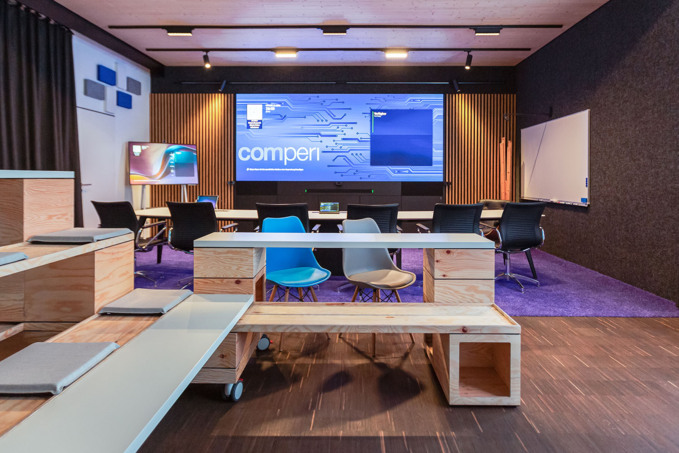One of the first and most important things you should pay attention to is ergonomics at the workplace. Back pain, tension and headaches are typical work-related ailments and the result of poor posture and a lack of ergonomic office equipment.
.
You can only influence how your employees sit down to a limited extent, for example in training sessions in which you sensitize employees to healthy sitting at the workplace. What you can also do is to ensure ergonomic office chairs and desks. This means that the desk should be at a height of between 68 and 72 centimetres and ideally be adjustable so that employees can sometimes work standing up. Ergonomic design should also be ensured for other office equipment and hardware components such as chairs, screens and computer mice.
1. space: no one should feel cramped in the open-plan office
Reversible offices or the open space office have become indispensable in times of hybrid working. More and more employees are working from home and only come into the office once or twice a week. As a result, fixed workstations are passé and the open-plan office is a very popular model. Whether the employees have assigned workstations or not, the important thing is that there is enough space for everyone in the open-plan office.
Even on a day when the office is full, every employee should have at least 10 m2 for themselves. Those who feel cramped cannot concentrate, are more easily irritated and simply feel uncomfortable. Space is also an important factor for noise levels – the closer the workstations are designed, the easier it is for one person's customer conversations to disturb the other's work.
Even if rental space is expensive, it is therefore advisable not to skimp on it. You should also not forget: Make sure there is enough space for rescue routes!
2. light and noise – avoid overstimulation
Two other important factors in office planning are the light conditions and the noise level. It is particularly important in large rooms that the acoustics do not make too much of a dent. Therefore, make sure to improve the acoustics in the office as much as possible by providing sufficient soundproofing.
Lighting can also have an impact on employees' ability to concentrate. To ensure that individual employees have as much say as possible, we recommend divided ceiling lighting or individual table lamps that make individual light settings possible.
3. a beautiful workplace also motivates
What you should also not forget when planning your office is the look. This also plays an important role in motivation. If you feel comfortable and have an appealing and organized workplace, it is easier for you to get down to work.
Plants, pinboards or plants are a decisive factor in office planning. The important thing is that it doesn't get out of hand: Splashes of color are beneficial to freshen up the office and brighten the mood, but should also not be a visual overload.
Are you unsure how much you can have? Talk to your employees and let them help decide, because their opinion is ultimately what counts.
4. the (technical) equipment for office planning
Last, but not least, the technical and non-technical equipment is important when it comes to office planning. Non-technical equipment includes, for example, desks and office chairs, which should be ergonomic. Equally important, however, are the hardware and software with which you equip your office. For example, high-quality displays help you to give better presentations and pass on important information to colleagues and customers.
Fundamentally, modern and efficient technology makes everyday work easier for every employee. Software that runs flawlessly and video conferences that can be started with just a few clicks ensure a smooth workflow. Anyone who has ever had audio or video interruptions during an important meeting knows how nerve-wracking faulty technology can be. Therefore, when planning your office, make sure you have the right technical equipment. An investment here will pay off in the long term for you, your company and your employees!
